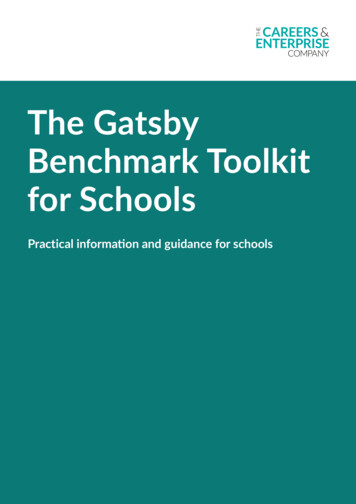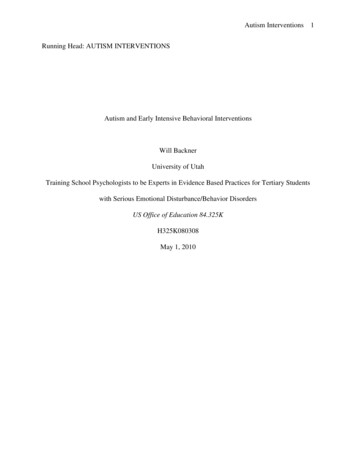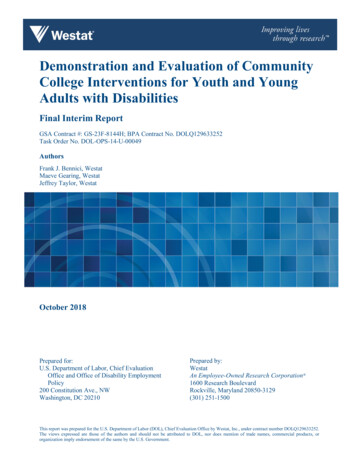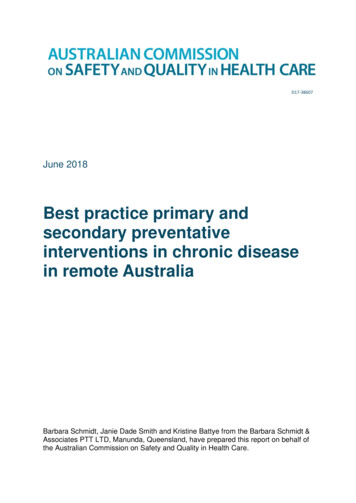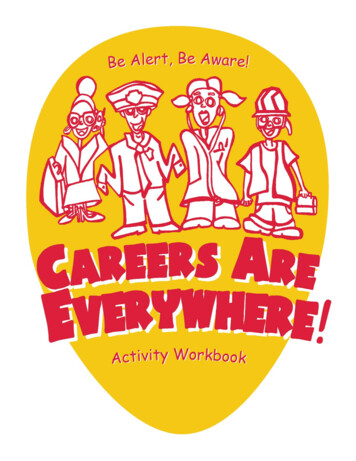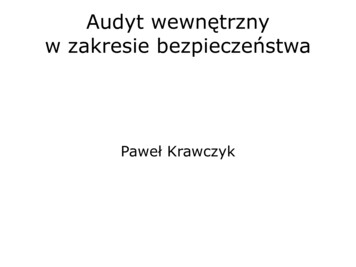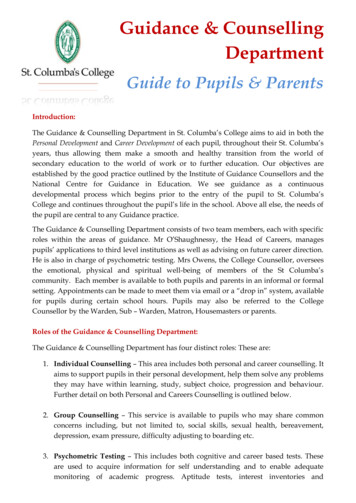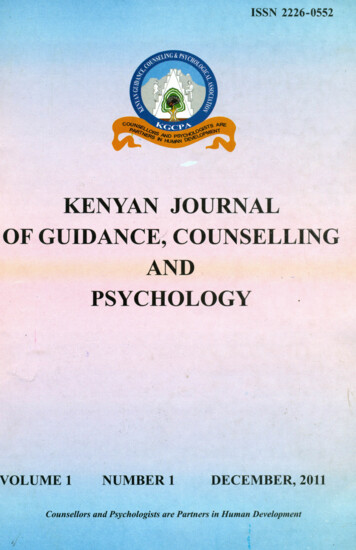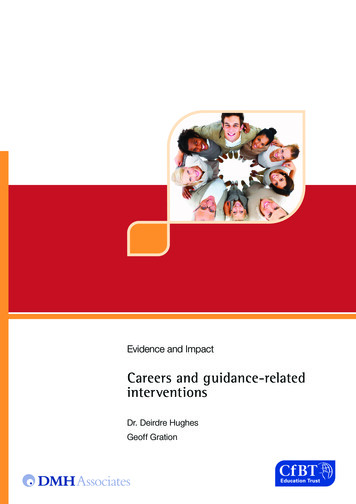
Transcription
LITERATURE REVIEWEvidence and ImpactCareers and guidance-relatedinterventionsDr. Deirdre HughesGeoff Gration
Evidence and Impact Careers and guidance-related interventionsContentsAcknowledgementsUsing this resourceContentsIntroduction1.Key questions about evidence1.1Introduction1.2 The challenge of measuring and assessingimpact: some headlines1.3‘Soft’ versus ‘hard’ outcomes1.4Some key terms and definitions1.5 What are the possible ‘outcomes’ (‘impactmeasures’) of careers and guidance-relatedinterventions?1.6 The nature of evidence: are some types ofevidence better than others?3. Strategies, tools and ‘tips’ formeasuring and assessing impactof careers and text3.2.1 An effective Integrated YouthSupport Service3.2.2 The process for joint planning andcommissioning of IAG services for youngpeople: impact assessment3.2.3 Key performance indicators (KPIs) beingused by local authorities in their work withConnexions services3.2.4 Inspection and quality standards frameworks3.2.5 Soft outcomes – a hard call?3.3 Gathering evidence and reporting on impact1.7A five-level model of robustness of evidence3.3.1 Strategic: Connexions services impactassessment approaches2.The evidence base3.3.2 Strategic: Connexions services ‘macroimpact reports’2.1 Ten Key Facts ‘Careers Specialists KnowFor Sure’3.3.3 Operational: Connexions services impactassessment activities2.1.1Background2.1.2Connecting talent with opportunities4.The customer voice: personalisation2.1.3The key facts4.1Introduction2.2News stories and impact statements4.2Involving young people2.2.1Participation, attainment and progression4.3Careers and guidance-related policy2.2.2 News stories4.4Practical approaches2.2.3 Impact statements4.5Young people’s voices5.Conclusion5.1Looking ahead2.3 The literature review – Evidence and Impact:Careers and guidance-related interventions2.3.1Overview2.3.2 Decision-making processes of young people2.3.3 Remotely delivered information, advice andguidanceAppendix 1:2.3.4 Evaluation surveys of Connexions servicesLinks to other resources and websites2.3.5 Targeted support for young people2.3.6 Generic careers-related impact research2.3.7 Other findingswww.cfbt.comAppendix 2:Glossary
Evidence and Impact Careers and guidance-related interventionsAcknowledgementsWe are grateful to CfBT Education Trust for their commitment and financial investment in supporting theproduction of this online professional resource. The development project has also resulted in a publishedliterature review of research on the impact of careers and guidance-related interventions and a synthesispaper. We are indebted to the CfBT Research and Knowledge Management and Design teams for theirhelpfulness and expertise provided to us.We also wish to express our sincere thanks to Connexions representatives, local authority managersand software developers who gave us both time and practical materials that have informed much ofthe content of this professional resource. In addition, we are indebted to young people in London andthose who participated from further afield, as part of the National Youth Panel Forum, for their honestyand frankness. The Supporting Children and Young People Group within the Department for Children,Schools and Families (DCSF) at Moorfoot, Sheffield, provided invaluable support in reviewing earlierdrafts.Several people have contributed a great deal of feedback and suggestions to this professional resource,especially Simon Bysshe, Nikki Moore, Aminder Nijjar, Joanna van de Poll, Keith Stead and ProfessorMark Savickas.Finally, Professor Jenny Bimrose, Principal Research Fellow, Warwick University was commissionedby CfBT to act as peer reviewer of this professional resource and associated literature review. We aregrateful to her for the constructive feedback received.www.cfbt.com1back to contents
Evidence and Impact Careers and guidance-related interventionsUsing this resourceWho is this professional resource for?This professional resource is aimed at policymakers, managers, practitioners and trainers to informthe evidence base for careers and guidance-related interventions within an Integrated Youth SupportService (IYSS) context in England.What does the professional resource seek to do?It specifically focuses upon impact assessment and measurement issues that need to be addressed inrelation to accountability and service design and delivery so that effective careers and guidance-relatedprovision is made available to all young people.The resource also provides: key facts and impact statements supported by research findings; and strategies, tools and ‘tips’ that can be applied to everyday practice.How should the professional resource be used?The contents are wide ranging and they have been specifically designed to provide a flexible andadaptable set of materials relevant to policy and practice which are accessible through the EducationalEvidence Portal (eep). The user can choose from a series of impact-related background issues, keyfacts, impact statements, and practical strategies, tools and tips. By making use of the hyper-linksavailable throughout the online resource the user can access materials to suit his or her individual needs.www.cfbt.com2back to contents
Evidence and Impact Careers and guidance-related interventionsIntroductionRecent changes in the machinery of government are necessitating a major rethink in the strategicplanning, funding and delivery of local services for all young people, adults, training providers andemployers. Newly devolved arrangements from central to local government for the commissioning of14-19 services, as outlined in the Children’s Plan,1 include requirements for a seamless universal andtargeted support service with significantly improved careers education, information, advice andguidance (CEIAG) in all schools and colleges.2 It is within this context that integrated youth supportservices (IYSS) in England will be expected by government to ensure the delivery of a new 14-19entitlement for all young people as outlined in the government’s report on 14-19 Reform: Next Steps(DCSF, 2008).3 Policy developments are unfolding at a rapid pace with new national information,advice and guidance quality standards and new legislation in place. Local authorities and theirpartner organisations are now required to give greater attention to the role of impartial careerseducation, information, advice and guidance.The Education and Skills Act (2008) received royal assent in December 2008. The legislation specifiesa rise in the participation age in young people’s education and training from 16 to 17 by 2013 andfrom 17 to 18 by 2015. In the Government’s 2009 Budget, an extra 54,500 places for 16 and 17 yearolds in school and colleges as well as 17,500 places allocated to expand 16-17 apprenticeships wereannounced. From this and other related developments, it is clear that services will become increasinglyaccountable for reporting on the impact of their services and provision.Given the raising of the compulsory participation age to 184 and the entitlement to access all four ofthe 14-19 qualification routes, including the 17 Diploma lines by 2013,5 there is a renewed interest inConnexions and CEIAG outcomes and performance indicators i.e. the theory being that NEETfigures at 16 should ‘technically reduce’; therefore new universal ‘performance indicators’ will berequired to assess the impact of careers work in general. This necessitates new knowledge and skillsdevelopment, not only for young people and parents/carers, but also for those working in localauthorities, schools, colleges, and with employers and training providers.Finding new ways of measuring and assessing the impact of careers and guidance-relatedinterventions is a challenge which now needs to be met.1Department for Children, Schools and Families (2007) The Children’s Plan: Building Brighter Futures. The Stationery Office, Norwich: England, December 2007An ‘end-to-end review’ of careers education and guidance (DfES, 2005a) found that there was a significant problem over the priority given to career education in schools, collegesand work-based training. It concluded that ‘the greatest potential for improving career education and guidance delivery lies in driving up the quality and relevance of careerseducation in schools’.Department for Children, Schools and Families (2008) Delivering 14-19 Reform: Next Steps. October 2008.Op. cit.Department for Education and Skills (2005b) 14-19 Education and Skills Implementation Plan. London: Department for Education and Skills.2 345www.cfbt.com3back to contents
Evidence and Impact Careers and guidance-related interventions1.Key questions about evidence1.1 Introduction1.2 The challenge of measuring and assessing impact:some headlines1.3 ‘Soft’ versus ‘hard’ outcomes1.4 Some key terms and definitions1.5 What are the possible ‘outcomes’ (‘impact measures’)of careers and guidance-related interventions?1.6 The nature of evidence: are some types of evidence betterthan others?1.7 A five-level model of robustnessof evidencewww.cfbt.com4back to contents
Evidence and Impact Careers and guidance-related interventions1. Key questions about evidence1.1 IntroductionEffective guidance-related interventions are at the heart of several core UK policy initiatives such asEvery Child Matters and the Raising of the Participation Age. Not surprisingly, the UK Governmentinvests considerably large amounts of time and money into the provision of information, adviceand guidance (IAG). Being able to assess the effectiveness of IAG is important for policymakers todemonstrate the impact of these policies and to justify current levels of funding in the associatedservices. But evidence-based practice is also important for service managers to enable them to deployand target resources more effectively and to achieve quality standards. Equally, it is important forpractitioners to be able to identify good practice and to be able to reflect upon their own performanceand improve the contribution they make. Evidence-based practice also serves to maintain a focus uponthe customer and the customer’s voice, and upon the customer’s needs and the extent to which theservice is meeting these.If assessing the impact of IAG is considered important by policymakers, managers and practitionersalike, is there general agreement about what constitutes impact and what should be measured andassessed? Much of the performance of IAG services is monitored in terms of targets that are oftenseen to be imposed ‘top down’ from policymakers and funding bodies, and are often restricted to thosethat are most easily observable and measurable such as volumes of delivery, qualification levels andemployment statistics. There may be other benefits to customers that are not so easily quantifiable butare nevertheless just as valid and important. Indeed, it could be argued that measuring the impact ofany public policy initiative is inherently problematic given the complexity of human behaviour and thedifficulty in teasing out the many influences and factors involved.1.2 The challenge of measuring and assessing impact:some headlinesThe introduction of target-driven approaches to publicly funded services, in career guidance and inother areas such as health and the police, raises a number of challenges such as: C an the true impact of public policy initiatives ever be realistically measured given the complexity ofhuman behaviour and the interaction of so many variables? I f so, what measures should be used to avoid any unintended or ‘perverse’ consequences ofintroducing a target-driven culture? ow should the data be collected and interpreted to avoid or minimise anyHbias from the researchers themselves and from the policymakers?Drawing upon a variety of sources, includingresearch reports and the news media,we have devised a number ofheadlines to present some of thesechallenges and issues in an easilydigestible way with links to theunderpinning detail.www.cfbt.com5back to contents
Evidence and Impact Careers and guidance-related interventions1. Key questions about evidenceThe careers guidance community is not alone in the difficult task of showing that it makes adifference; trying to quantify the impact of most public policy initiatives can be like searchingfor the ‘holy grail’.Keep (2004) specifically cautions that trying to relate education and training outputs (such asparticipation rates and qualification levels) to their impact on wider social and economic outcomes isfraught with difficulty. ‘The linkages between levels of education and training within the workforce orsections thereof and subsequent performance at the level of the firm, sector or national economy areextremely complex and subject to intervention by a very wide range of other factors’ (p.17).Reference: Keep, E. (2004). The Multiple Dimensions of Performance: performance as defined by whom,measured in what ways, to what ends? Nuffield Review of 14–19 Education and Training Working Paper 23.Available ocuments29-1.pdfThe inherently complex nature of human behaviour, and the many interacting factors and influencesinvolved, presents a major difficulty in demonstrating the impact of public policy initiatives and makesreaching clear conclusions ‘hazardous’, to say the least. This complexity of human behaviour isillustrated by a Joseph Rowntree Foundation study (Cassen & Kingdom 2007) in which the possiblevariables associated with low achievement in schools include an interaction of many factors, only oneof which is the quality of the school and the impact of the school experience. They indicate that otherfactors are at play, such as ethnicity, gender and the levels of socio-economic disadvantage of theindividual pupils.Reference: Cassen, R. and Kingdon, G. (2007). Tackling low educational achievement. York: JosephRowntree Foundation.Although there appears to be a general consensus that social mobility in Britain did not improvebetween 1970 and 2000 despite the huge economic, social and political changes that took place, thereis disagreement on the level of social mobility achieved since 2000 with the data being interpreteddifferently according to political perspectives. The Labour Government argues that new researchfindings (Cabinet Office 2008) show an improvement in social mobility thereby demonstrating theimpact of their policies such as increased nursery places, better education leading to improvingexam results, more people staying on at school after the age of 16 and better on-the-job training. TheConservatives, on the other hand, point to the tentativeness of the conclusions reached by the researchand the ‘fractional’ nature of the impact perceived relative to the size of the public spending involved.Reference: Cabinet Office (2008). Getting on, getting ahead. A discussion paper: analysing the trends anddrivers of social mobility. London: Cabinet gon.pdfBBC News web page, Monday, 3 November 2008. Accessed 12.11.08 at:http://news.bbc.co.uk/1/hi/uk politics/7705444.stmDemonstrating impact can be very difficult even when looking at targeted and highly specific publicpolicy initiatives. For example, a Learning Skills Development Agency (LSDA) review of regionalvariations in NEET (Sachdev et al. 2006) reports that up to 2006 the national roll-out of EMAs hadshown much more modest gains in participation at age 16 than was expected with only 1 percentagepoint increase compared to the anticipated rise of 4 percentage points. By the age of 19, EMA hadceased to have any noticeable effect on participation in full-time education and there was no significanteffect on attainment levels. This data has led some researchers to question the cost-effectiveness ofEMAs and the return against investment. Delorenzi and Robinson (2005) suggest strongly that: ‘TheEMA may have been over-sold as an instrument for improving participation and especially attainment’(p. 90).References: Sachdev, D., Harries, B. and Roberts, T. (2006). Regional and sub-regional variation in NEETs –reasons, remedies and impact. London: Learning and Skills Development Agency.Available wr-lsn-neetstudy-2006.pdfDelorenzi, S. and Robinson, P. (2005). Choosing to Learn: Improving participation after compulsory education.London: IPPR.www.cfbt.com6back to contents
Evidence and Impact Careers and guidance-related interventions1. Key questions about evidenceThe proportion of young people not in employment, education and training (NEET) has provedstubbornly resistant to public policy intervention and has hovered at around 10% since the mid-1990s(Nuffield Review/Rathbone 2008). This is despite significant investment in targeted support and otherpolicy measures; indeed, the figures since the mid-1980s indicate that the overall buoyancy of theeconomy in terms of general employment rates could possibly be the most significant factor associatedwith NEET.Reference: Nuffield Review/Rathbone (2008). Rathbone/Nuffield Review Engaging Youth Enquiry: Finalconsultation report. London: The Nuffield Review of 14–19 Education and Training. Available ocuments196-1.pdfMany Performance Indicators (PIs) focus upon that which can be easily measured,i.e. counting that which can be measured rather than measuring what countsKeep (2004) argues that performance targets within the provision of education and training tend toembody the priorities of central government, and act as a set of perverse incentives which makeco-operative management of the system harder than it needs to be, focusing as they do on thatwhich can easily be measured in education and training, e.g. volumes of delivery and qualifications.He indicates that the profile of measures needs to be more balanced and comprehensive and shouldinclude qualitative as well as quantitative information, and longer-term outcomes such as employmentand earning patterns as well as short-term measures such as qualification levels.Reference: Keep, E. (2004). The Multiple Dimensions of Performance: performance as defined by whom,measured in what ways, to what ends? Nuffield Review Working Paper 23. Available ocuments29-1.pdfIn their survey of performance indicators in career guidance in the UK, Hughes & Gration (2006) detailthe extensive range and volume of data collection carried out by all of the main providers of information,advice and guidance (IAG), including: customer characteristics; types and numbers of serviceinterventions; and a variety of service outcomes, usually in terms of employment and education/trainingoutcomes. They indicate that although there is no shortage of IAG-related data collection much of it isrequired by funding bodies for the purposes of contract compliance and contract renewal/tenderingprocesses with little scope for the needs of practitioners to use it to improve their practice.Reference: Hughes, D. & Gration, G. (2006). Performance Indicators and Benchmarks in Career Guidancein the United Kingdom. CeGS Occasional Paper. Derby: Centre for Guidance Studies (CeGS), University ofDerby. Available from:http://www.derby.ac.uk/files/icegs performance indicators and benchmarks2006.pdfA report to the Higher Education Funding Council for England (CHERI 2008) highlights some of thepresentational and interpretative difficulties associated with the publication of HE institutional datain the form of five major league tables. These include the perceived tension between league tableperformance and institutional and governmental policies and concerns (e.g. on academic standards,widening participation, community engagement and the provision of socially-valued subjects).The report concludes that, given the increasing influence of the league tables, there is an onus onpolicymakers and institutions themselves to promote greater public understanding of league tables andalternative sources of information about higher education. There is also an argument for codifyinggood practice in the compilation of rankings as a reference point for both compilers and users ofleague tables.Reference: CHERI (2008). Counting What Is Measured or Measuring What Counts? League Tablesand Their Impact on Higher Education Institutions in England. London: HEFCE. Available from:http://oro.open.ac.uk/11799/1/Locke%2C W. et al (2008) Counting What is Measured Or MeasuringWhat Counts - League Tables %26 Their Impact On HEIs in England.pdfwww.cfbt.com7back to contents
Evidence and Impact Careers and guidance-related interventions1. Key questions about evidence‘Chasing targets’ can sometimes have unintended, often self-defeating or ‘perverse’consequences.There have been many headlines in the media on how target setting and ‘target chasing’ may havereduced the quality of patient care in the NHS, or may have resulted in unnecessary bureaucracy.For example, the Times online, under the headline ‘Poor leadership and chasing targets hamperspatient care’, reported that: ‘A lack of leadership, inadequate team-working and focusing too muchon government targets emerged as common themes in the Healthcare Commission’s review of its13 major investigations between 2004 and 2007. It concluded that some boards were focused onmergers between organisations after a shake-up of NHS trusts, or on meeting targets at the expenseof patient care.’Reference: Times online, health/article3300539.eceSimilarly, the Telegraph online, under the headline ‘Chasing politically driven targets’ reported theviews of one doctor on the possible consequences of a new contract: ‘An increasing part of our paywill be conditional on meeting politically driven targets set by the Department of Health. Instead ofbeing independent advocates for patients, we will be encouraged to pressurise patients into acceptingtreatments ordained by government diktat. This will have a corrosive effect on the doctor-patientrelationship and, as it has done in the hospital sector, pervert clinical priorities. An increasing amount ofour already limited time will also be needed to collect a bewildering amount of data, ready for inspectionby the new health police body that is to be established for this task.’Reference: Telegraph online, t is not only doctors who worry that ‘target chasing’ may make them less, not more, effective. Underthe headline ‘Police chief says officers chasing targets distort picture of crime’, the Times online reportsthe views of Sir Ronnie Flanagan, HM Chief Inspector of Constabulary, who called for an urgent needfor national leadership on cutting bureaucracy and for police officers on the front line to begin toexercise judgment and discretion. The picture of violent crime in Britain is being distorted by nervouspolice officers recording minor incidents such as playground squabbles as serious incidents. Policeofficers who complained about mountains of unnecessary paperwork were responsible for generatingmuch of it themselves as a result of a ‘just in case’ culture in the service.Reference: Times online, crime/article2441818.eceIn their book Freakonomics, Levitt and Dubner (2005) write about some of the more unusual aspectsof economic policies and some of their unintended and occasional perverse consequences. ‘For everyclever person who goes to the trouble of creating an incentive scheme, there is an army of people,clever or otherwise, who will inevitably spend even more time trying to beat it. Cheating may or maynot be human nature, but it is certainly a prominent feature in just about every human endeavour.’(p.24) They go on to quote an example in education where a culture of accountability is based uponexamination results. ‘In a recent study of North Carolina school teachers, some 35% of the respondentssaid they had witnessed their colleagues cheating in some fashion, whether by giving students extratime, suggesting answers, or manually changing students’ answers.’ (p.34)Reference: Levitt, S.D. & Dubner, S.J. (2005). Freakonomics. London: Penguin Books.www.cfbt.com8back to contents
Evidence and Impact Careers and guidance-related interventions1. Key questions about evidence1.3 ‘Soft’ versus ‘hard’ outcomesAs indicated in the previous section, one of the many issues involved in measuring andassessing impact is agreeing what measures should be used. Central to this is a discussion of‘soft’ versus ‘hard’ outcomes.The term ‘outcome’ is commonly used to describe the effect that a service has had, either on theindividual customer, or on the wider community, or for the economy as a whole. In this sense, ‘outcome’is frequently used to describe the ‘impact’ of a service. So-called ‘hard outcomes’ are those thatcan be easily seen and measured in terms of simple quantities. For example, in the case of a trainingprovider this could include a given percentage increase in the number of trainees gaining a recognisedqualification. In the case of Connexions services it would include a percentage reduction in 16-18 yearolds not in employment, education or training (NEET). So called ‘soft outcomes’ are those that aremore subjective, more qualitative and often not so easy to quantify. For example, they could includepositive changes of a personal nature such as increased self-esteem, self-confidence, motivation,independence, or decreased aggression and a better ability to cope positively with stress.Within the context of IAG, soft outcomes such as increased self-confidence and motivation are oftenseen as intermediary and necessary stages (or ‘precursors’) towards achieving a longer-term, harderoutcome, such as gaining employment after a significantly long period of unemployment. ‘Distancetravelled’ is often used to refer to the progress individuals make in achieving soft outcomes thatmay contribute to, and ultimately lead towards, sustained employment or associated hard outcomes.Measuring distance travelled normally requires assessing an individual on at least two separateoccasions (and preferably more) to understand what has changed.Because of the need for government and funding bodies to demonstrate value for money and theimpact of their social and economic policies, it is clear that they will continue to set targets for IAGservices that focus upon the ‘harder outcomes’. For example, the new National Indicators for LocalAuthorities and Local Authority Partnerships, introduced for use in 2008/2009, provide numericaltargets for the performance of 14-19 local partnerships that include: Level 2 and Level 3 attainment at19 years of age; participation of 17 year olds in education and training; and the proportion of 16-18 yearolds who are NEET.Despite the government emphasis on these kind of targets, much of the available research evidencesuggests that it is not always easy to demonstrate the impact of IAG in terms of the ‘harder’ outcomes,especially those related to longer-term labour market outcomes. This is partly because of themethodological challenges in carrying out the necessary research with members of the public, andpartly because of the complex nature of human decision-making and the difficulties in teasing out themany different interacting influences and factors.There is, however, an extensive body of evidence demonstrating the impact of IAG upon the softer,precursor outcomes. In addition, the work of practitioners is often more directly focused upon thesesofter precursors, with outcomes such as helping customers clarify goals, improve job search skills,re-focusing and enhancing motivation and self-confidence. Not surprisingly, many techniques andinstruments have been developed to try and assess the impact of IAG and other related services interms of soft outcomes. Some of these are highlighted in greater detail in Section 3 (for example: CAF,the Rickter Scale, the SOUL Record, and Dare to Ask?).www.cfbt.com9back to contents
Evidence and Impact Careers and guidance-related interventions1. Key questions about evidence1.4 Some key terms and definitions‘Outcome’, ‘hard outcomes’, and ‘soft outcomes’ have already been defined as the terms commonlyused to describe the ‘impact’ of a service either upon the individual customer, or on the widercommunity, or for the economy as a whole. There are many other terms used within the context ofimpact assessment, some of which are briefly defined here. (A more comprehensive coverage of keyterms and definitions is given in the Glossary.)The term ‘outputs’ is commonly used to refer to a provider’s levels of activities and services. Thiscould include a provider’s volumes of delivery, its ‘turnover’, or ‘throughput’, for example the numberof interventions delivered per quarter or the number of interventions per client. Sometimes theterms ‘outputs’ and ‘outcomes’ are used interchangeably, though it is more appropriate to use themseparately in the way described above.‘Inputs’ refers to the allocation of resources – both human and material – that contribute to theunderlying ‘processes’ which provide the necessary foundation for the delivery of services. There arealso several different ‘models’ that seek to relate ‘inputs’ and ‘processes’ to ‘outputs’ and outcomes’ inthe form of overarching impact assessment or quality assurance ‘frameworks’.There are many different types of research ‘methodologies’ used to assess the impact of IAG services.Some of these are ‘qualitative’ in nature focused upon, for example, listening to what customers haveto say about services in ‘focus groups’ or through ‘one-to-one interviews’. Others are ‘quantitative’in nature
14-19 services, as outlined in the Children's 1Plan, include requirements for a seamless universal and targeted support service with significantly improved careers education, information, advice and guidance (CEIAG) in all schools and colleges.2 It is within this context that integrated youth support
